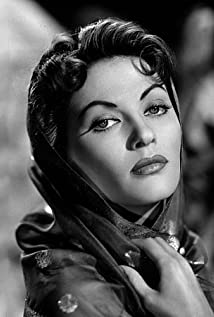Yvonne De Carlo was born Margaret Yvonne Middleton on September 1, 1922 in Vancouver, British Columbia, Canada. She was three when her father abandoned the family. Her mother turned to waitressing in a restaurant to make ends meet--a rough beginning for an actress who would, one day, be one of Hollywood's elite. Yvonne's mother wanted her to be in the entertainment field and enrolled her in a local dance school and also saw that she studied dramatics. Yvonne was not shy in the least. She was somewhat akin to Colleen Moore who, like herself, entertained the neighborhood with impromptu productions. In 1937, when Yvonne was 15, her mother took her to Hollywood to try for fame and fortune, but nothing came of it and they returned to Canada. They came back to Hollywood in 1940, where Yvonne would dance in chorus lines at night while she checked in at the studios by day in search of film work. After appearing in unbilled parts in three short films, she finally got a part in a feature.
Although the film Harvard, Here I Come! (1941) was quite lame, Yvonne glowed in her brief appearance as a bathing beauty. The rest of 1942 and 1943 saw her in more uncredited roles in films that did not quite set Hollywood on fire. In The Deerslayer (1943), she played Wah-Tah. The role did not amount to much, but it was much better than the ones she had been handed previously. The next year was about the same as the previous two years. She played small parts as either secretaries, someone's girlfriend, native girls or office clerks. Most aspiring young actresses would have given up and gone home in defeat, but not Yvonne. She trudged on. The next year, started out the same, with mostly bit parts, but later that year, she landed the title role in Salomé (1945) for Universal Pictures. While critics were less than thrilled with the film, it was at long last her big break, and the film was a success for Universal. Now she was rolling.
Her next film was the western comedy Era su destino (1945) as Lorena Dumont. After a year off the screen in 1946, she returned in 1947 as Cara de Talavera in El canto de Sherezada (1947), and many agreed that the only thing worth watching in the film was Yvonne. Her next film was the highly regarded Burt Lancaster prison film Entre rejas (1947). Time after time, Yvonne continued to pick up leading roles, in such pictures as Esclava (1947), Los amores de Lola Montes (1948), Casbah (1948) and La reina del río (1948). She had a meaty role in Sin ley y sin alma (1949), a gangster movie, as the ex-wife of a hoodlum. At the start of the 1950s, Yvonne enjoyed continued success in lead roles. Her talents were again showcased in movies such as El águila del desierto (1950), Pasión al rojo vivo (1951) and Mi vida es mía (1952). Her last film in 1952 was El capitán huracán (1952), a picture most fans and critics agree is best forgotten.
In 1956, she appeared in the film that would immortalize her best, Los diez mandamientos (1956). She played Sephora, the wife of Moses (Charlton Heston). The film was, unquestionably, a super smash, and is still shown on television today. Her performance served as a springboard to another fine role, this time as Amantha Starr in Mi pecado fue nacer (1957). In the late 1950s and early 1960s, Yvonne appeared on such television series as Bonanza (1959) and Los invencibles (1962). With film roles drying up, she took the role of Lily Munster in the smash series La familia Munster (1964). However, she still was not completely through with the big screen. Appearances in such films as Hombre de verdad (1963), El poder diabólico (1968), The Seven Minutes (1971) and La casa de las sombras (1976) kept her before the eyes of the movie-going public. Yvonne De Carlo died at age 84 of natural causes on January 8, 2007 in Woodland Hills, California.

